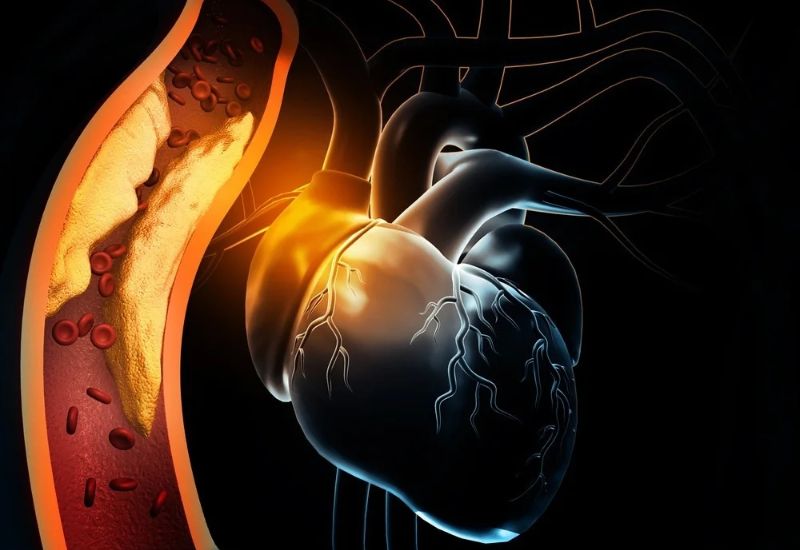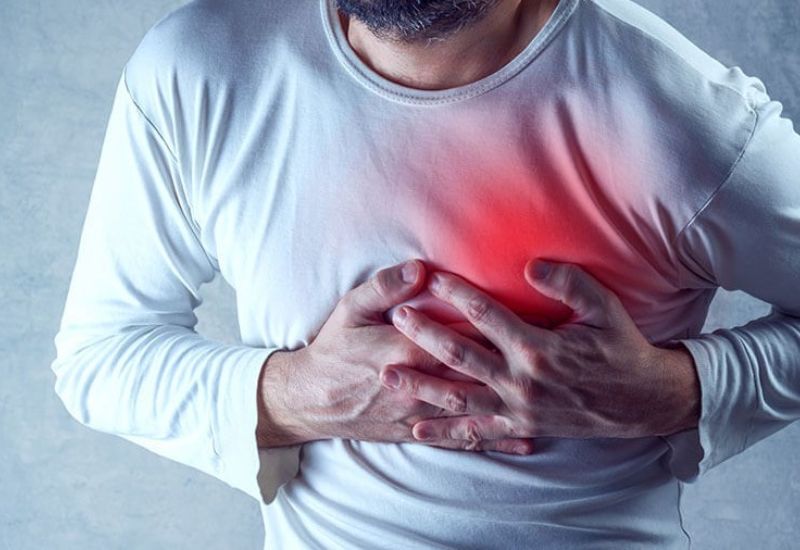Myocardial infarction, commonly known as a heart attack, is a severe cardiovascular event that can lead to numerous complications and even death if not treated promptly. Understanding the causes and recognizing the warning signs are crucial for timely intervention and reducing the risk of fatal outcomes.
1. Causes and Risk Factors of Myocardial Infarction
A myocardial infarction occurs when the coronary arteries (blood vessels responsible for supplying blood to the heart muscle) become suddenly blocked. This blockage prevents the heart muscle from receiving enough blood, which can result in tissue death. This is the most dangerous cardiovascular event because the death of heart muscle tissue affects the heart’s ability to pump blood, potentially leading to heart failure or death.

If deprived of blood supply, the heart muscle can become necrotic, leading to an acute myocardial infarction.
1.1 Common Causes
The most common cause of myocardial infarction is the formation and growth of atherosclerotic plaques within the arteries. These plaques are composed of cholesterol, calcium, and cellular debris. Over time, these plaques can enlarge, narrowing the blood vessels and impeding blood flow, ultimately causing a lack of blood supply to the heart muscle. In some cases, plaques can rupture, leading to the formation of a blood clot that can completely block the artery.
1.2 Risk Factors
Several factors increase the risk of developing atherosclerosis and subsequent myocardial infarction:
– Lipid Disorders: The presence of high levels of bad cholesterol (LDL) and triglycerides in the blood can lead to the accumulation of plaques in the arteries. When these plaques grow to a significant size, they can block blood flow to the heart muscle. Additionally, plaque rupture can lead to blood clots and localized blockages.
– Hypertension: Chronic high blood pressure puts extra stress on the arteries, making them more susceptible to damage and plaque formation. This can lead to sudden arterial ruptures and acute myocardial infarction.
– Diabetes: Individuals with diabetes are at a higher risk of myocardial infarction due to the disease’s impact on blood vessels. Emergency intervention and treatment for diabetic patients are often more challenging.
– Unhealthy Lifestyle Habits: Smoking, excessive alcohol consumption, poor diet, obesity, and physical inactivity all contribute to an increased risk of coronary artery blockages. These habits can raise blood pressure, damage the arterial lining, and promote plaque formation.
– Unchangeable Factors: Age, gender, family history, and personal history of cardiovascular diseases are risk factors that cannot be modified but significantly contribute to the risk of myocardial infarction.
2. Symptoms of Myocardial Infarction
2.1 Warning Symptoms
While a myocardial infarction can occur suddenly without any prior warning, there are often symptoms that can indicate an impending heart attack:
– Chest Pain: Pain or discomfort in the left side of the chest, ranging from a heavy or burning sensation to sharp, stabbing pain, lasting more than 20 minutes.
– Anxiety and Palpitations: Feelings of anxiety and rapid heartbeat.
– Shortness of Breath: Difficulty breathing.
– Dizziness: Light-headedness or fainting.
– Nausea: Feeling sick or vomiting.
– Blood Pressure Changes: Either an increase or decrease in blood pressure.
– Cold, Clammy Skin: Cold and sweaty hands and feet.
– Mental Distress: Irritability, anxiety, or panic attacks.
– Loss of Consciousness: Fainting.
In some cases, patients may only experience fatigue or discomfort in the upper abdomen without the classic symptoms.

Angina is a significant warning sign of abnormalities in the heart muscle.
2.2 Acute Myocardial Infarction Symptoms
The hallmark symptom of an acute myocardial infarction is severe chest pain, often described as a crushing or squeezing sensation, that can radiate to the back, neck, jaw, shoulders, or arms. This pain persists even at rest and lasts longer than 15 minutes. Accompanying symptoms include fatigue, shortness of breath, sweating, panic, and fainting. The pain does not subside with nitrate medications.
In certain individuals, particularly the elderly, women, and diabetics, an acute myocardial infarction may not present with chest pain but with symptoms like shortness of breath, altered consciousness, fainting, or low blood pressure.
3. Dangerous Complications
Without timely treatment, a myocardial infarction can lead to severe complications both during and after the event.
3.1 During Acute Myocardial Infarction
– Arrhythmias: Damage to the heart muscle can disrupt electrical signals, causing irregular heartbeats. Some arrhythmias can be life-threatening and lead to sudden cardiac death.
– Cardiogenic Shock: A significant portion of the heart muscle loses its ability to pump blood, often occurring when over 40% of the heart muscle is damaged.
– Heart Failure: Damage to heart tissue can impair the heart’s ability to pump blood, leading to acute or chronic heart failure.
– Pericarditis: Inflammatory response causing fluid accumulation around the heart.
– Cardiac Arrest: Sudden cessation of heart function without warning signs.

Regular cardiovascular health check-ups and controlling risk factors such as lipid disorders and hypertension are ways to prevent this dangerous health issue.
3.2 Post-Myocardial Infarction
Patients who do not receive appropriate emergency care and intervention may face long-term complications such as:
– Severe Heart Failure or Cardiogenic Shock: Inability of the heart to pump blood efficiently, requiring mechanical support, vasopressor medications, or other interventions.
– Arrhythmias: Continued heart rhythm disturbances due to damaged heart tissue.
– Severe Mitral Valve Regurgitation: Rupture of the chordae tendineae can cause severe valve leakage.
– Ventricular Septal Rupture: A tear in the interventricular septum causing abnormal communication between the heart’s chambers.
– Free Wall Rupture: A tear in the heart wall causing bleeding into the pericardial space or heart rupture.
Regular cardiovascular health check-ups and attention to warning signs are essential for preventing myocardial infarction and its serious complications.








